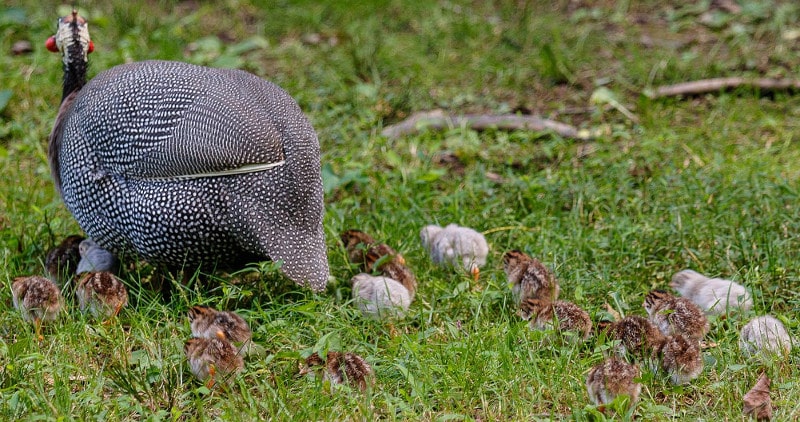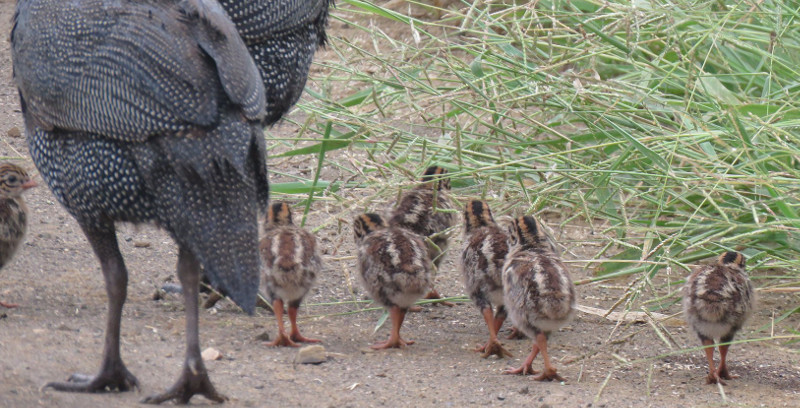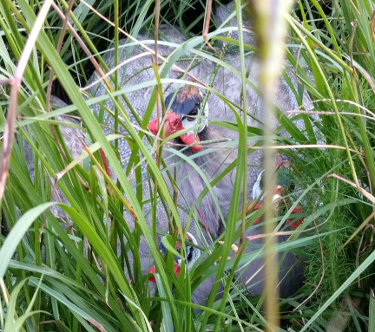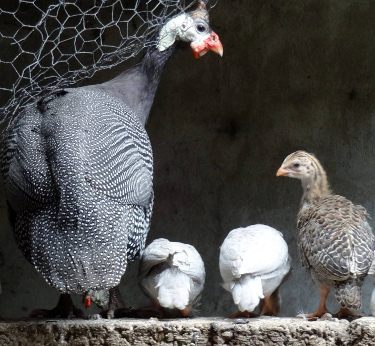Hatching Guinea fowl eggs naturally.

Natural hatching of Guinea fowl requires hatching eggs with a broody chicken, turkey or Guinea fowl itself. These are in order of desirability, the chicken is best, follow by a turkey hen and then the Guinea mother herself.
Then you need about 4 weeks to incubate under the bird. Guinea mothers are unpredictable and quite defensive.
Below: A mother hen with Guinea keets.

Raising Guineas from fertile eggs or with a hen is a natural popular method for starting your first guinea fowl flock. There is little difference to raising chickens although some of the practices vary a little.
Where to buy guinea fowl hatching eggs - Our for sale page or How to buy your guinea fowl.
Some sage advice form the past:
Lewis Wright in The Practical Poultry Keeper said in 1867: “To commence breeding Guinea-fowls, it is needful to procure some eggs and set them under a common hen.”
They knew back then the best way to hatch guinea fowl eggs and the advice hasn't changed in 140 years.
And he goes on to say:
"the Guinea hen lays pretty freely from May to about August. She is a very shy bird, and if eggs are taken from her nest with her knowledge, will forsake it altogether, and seek another, which she conceals with the most sedulous care. A few should therefore always be left, and the nest never be visited when she is in sight. It is best to give the earliest eggs to a common hen, as the Guinea-fowl herself frequently sits too late to rear a brood. If broody in due season, however, she rarely fails to hatch nearly all. Incubation is from twenty-six to twenty-nine or thirty days.”
Additionally, Mr Wright says that:
[Guinea] “chicks require food almost immediately within, at most, six hours after hatching and should be fed and cared for in the same manner as young turkeys, though they may be allowed rather more liberty. It should be observed, however, that they require more constant feeding than any other chickens, a few hours’ abstinence being fatal to them ; and they need also rather more animal food to rear them successfully and keep them in good condition, especially in the winter. The chicks are very strong on their legs, and in fine weather may be allowed to wander with the hen when very young.”
So can you just leave a Guinea hen on her nest?
Yes, with caveats.
This is the pot luck method where the hen sits on her eggs and hatches them out and you hope she doesn't get eaten or get them wet in the grass and kill them by accident.
Below: 3 Guinea hens sat communally on a nest. Communal nesting is a problem when using Guinea hens to brood.

If you are raising your Guineas in a coop or enclosed yard and want to encourage the hen indoors, setup a nest and place it in a dark, quiet area of the coop.
The ideal nest is not the same as you would use for a chicken, guineas prefer to sit in a hollow in the ground. The eggs will hatch in four weeks. This has maybe a 1 in 10 chance of working.
You do not need to do anything, this is the Guineas natural behaviour and will happen in late spring if you let it. I reckon about 25% of mine go broody. They are easy to turn as broody hens go, all you need to do is disturb the nest and she will be off.
Hatching fertile Guinea fowl eggs with a broody chicken:
Letting nature take its course and allowing a hen to incubate and hatch fertile Guinea eggs is the best method.
If allowed to roam, the Guinea hen will likely make her own nest on the ground and somewhere where you can not see it leaving her vulnerable to predation. You also can not move a guinea nest, they will just abandon it. This is why the chicken or turkey is a much better choice.
Silkies are a good choice to sit on your fertile Guinea fowl eggs as they make excellent and patient mothers.
Dust the mother and the nest with Diatomaceous Earth to keep parasites down.
Below: It can work with a Guinea hen but the odds are stacked against it.

If you bought Guinea fowl eggs from a poultry hatchery and the eggs were posted or couriered, allow the eggs to rest and come to room temperature for 6 to 12 hours before setting them.
Set the hatching eggs under the hen of choice and leave for 28 days. The incubation period for a Guinea fowl egg to hatch is 28 days but can vary between 26 and 30 days if the conditions are not correct during incubation. This is not normally a problem with natural hatching under a hen
The hen will keep the correct temperature of 37.5 Celsius or 99.5 Fahrenheit and keep the eggs at the ideal humidity whilst turning them regularly.
The final day of Guinea fowl egg turning is day 25 and they should pip in the next 24 to 48 hours after that. Allow 24 hours for the hatch to complete.
Most Guinea fowl eggs will hatch within the 28 days but weaker keets may hatch a day or two later. In the wild these would have been left in the nest to die. Only remove the keets when they are dry.
Feed the mother and chicks all the time with crumb and grated egg. Or use game fowl crumb or turkey crumb, the need the protein.
House the family in a confined coop or pen to start with to protect them from predators.
Feed the keets continuously. When the keets reach eight weeks of age, they should be large enough to be self-sufficient and will no longer require brooding.
The will likely still follow the mother hen around for another 3 to 4 weeks. I have seen them try to get under her wings on the roost at night, which is very amusing.
Discard any unhatched Guinea fowl eggs the main hatch and clean the nest.
